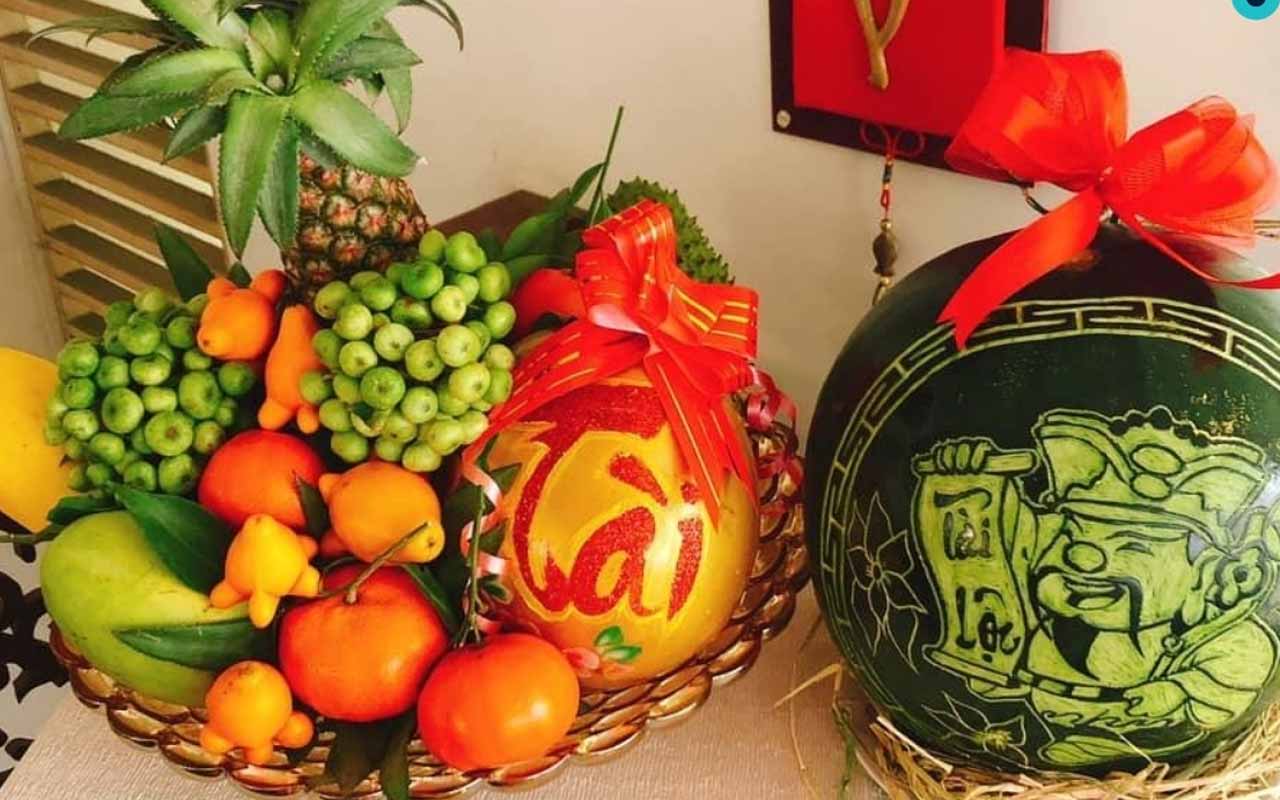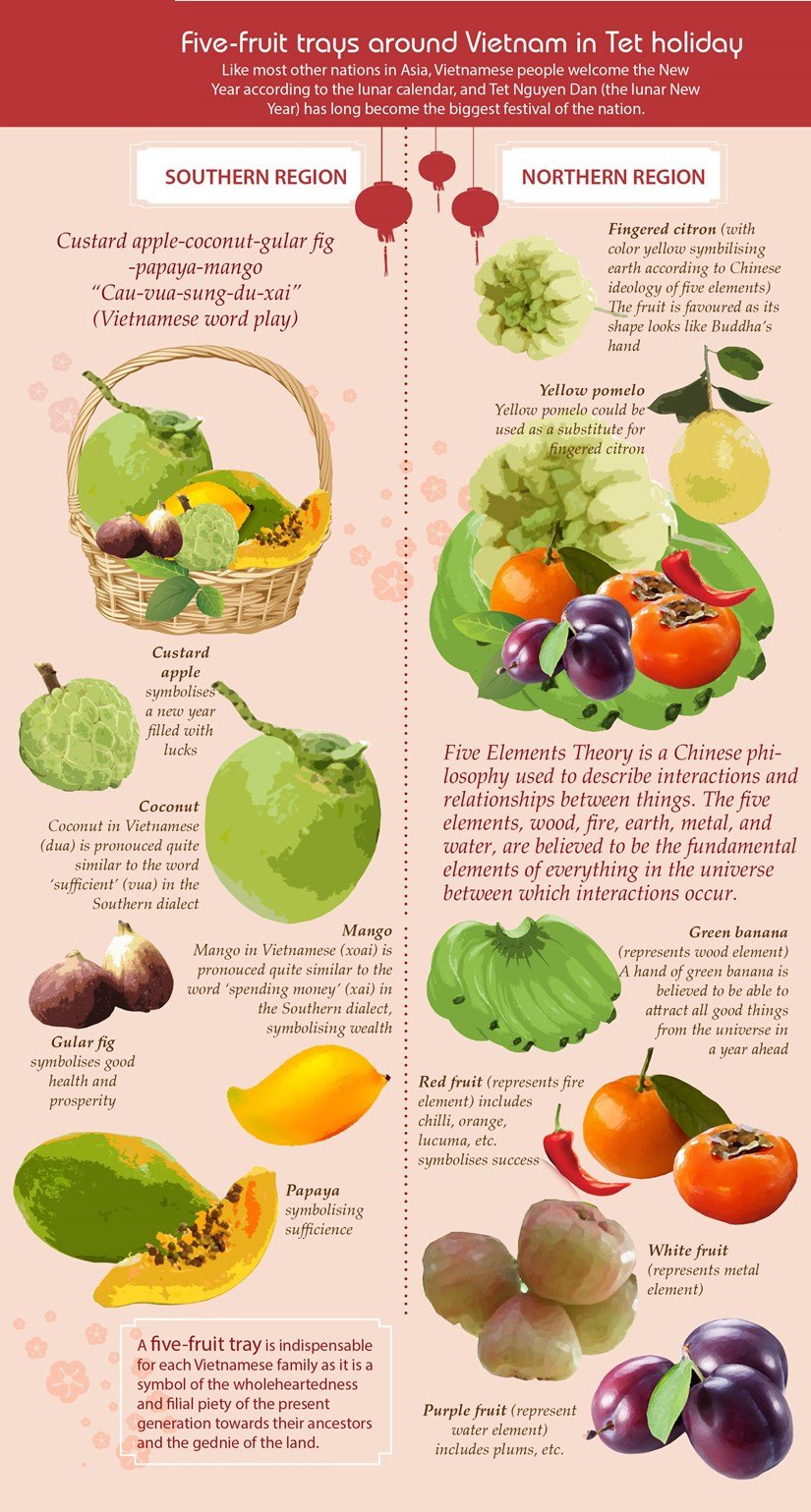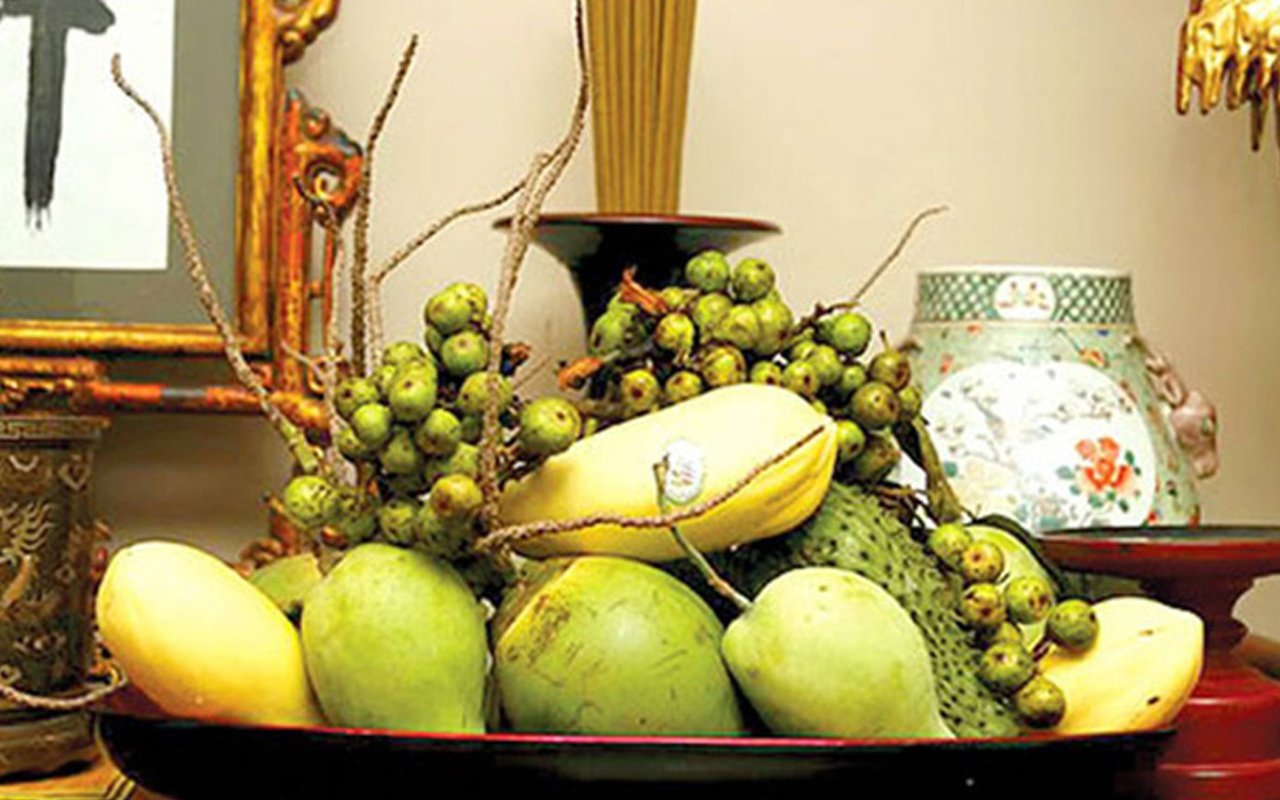Tet, almost everyone has the five fruits tray placed on an ancestral altar. That fruit tray, at least enough to try the five basic elements theory. If more, not limited and arrange the tower. Along with Banh Chung or Banh Tet, the five fruits trays on Tet is an indispensable thing on the ancestors’ altar on the Tet holiday of the Vietnamese people.
All Vietnamese families have altars. That is where the most sacred and solemn tribute to ancestors, grandparents should generally be located in time or place the highest of the house. The heart of the altar is a bowl of incense or also known as a censer. On the Tet holiday, the altar was cleaned, edit, compose carefully. All worship object from the censer, candles foot, water stations, flowerpot is polished, neatly put, right place. If wealthier families have horizontal lacquered.
Table of Contents
Tray of five fruits for Vietnamese Tet
We all know that plant banana trees familiar to every rural family (perhaps second only to bamboo). The banana tree is easy, grows on every land type. From village to plug land the open farm, the first is top a few banana roots, it withered yellow leaves at first but after few days, will rise to lush warm heart. And a few months later, a bunch of bananas, a necessitous family could bring the market to get more money for shopping gifts. With sufficient family supplements for young children do not need to buy. So the first fruit and basic is bananas intact green, is set as the stand for all other fruits.
The second fruit should have the grapefruit is no less familiar than anything little banana trees. If banana intact iridescent green, the color of the village familiar to many hopes. Grapefruit flowers are fragrant spring. Grapefruit fruit ripening in August is listed as hanging as the moon. On New Year, it is the fruit tray that is aspiration about full flowers and fruits of the garden.
Besides the two basic things that have fruit orange, representing the earth mother’s delicious sweet feed children from lifetime. Small blueberry, put to each slot of banana, add color embellishment. Add some hot pepper, it is the grace period for this tiny picture, and fire on the flickering sky deep blue inserts dark yellow and light yellow. Also, apple, Khe fruit with 5 sections make the tray full spring.
Some year nearly, Hanoi has Buddha’s hand fruit. How to call for it to hand the Buddha, because it does not plump like orange fruit, grapefruit, but is split into multiple fingers as support from the spring sky is coming to offering human happiness is life, enjoy the spring.
Buddha’s hand fruit, not fruit to eat that material for the spirit. It put on five fruits tray worship grandparents. Five fruits tray with Buddha’s hand fruit, the value is increased many times, many times more valuable. The section is tiny and sour, but the peel is filled with aromatic oils. After the New Year, It will be use soaked that wine delicious, precious.
Call 5 fruits tray because number 5 is the sacred with 5 basic elements, the law of the land creating heaven that we inherited the legacy of ancestors, ethnicity did not know from many life.
5 fruits tray are color, cubes, fragrance, production round of year farmers make, offer up the ancestor thanks for giving birth and creating.
Five-fruit tray of South Vietnamese people
For Southerners, five types of fruit are commonly found on the five-fruit tray: custard apple, coconut, papaya, mango, and fig.
In order for the five-fruit tray to be beautiful, choose the three largest fruits, papaya, coconut, and mango to the front. Then place the remaining fruits on top to form a pyramid. When choosing to buy, you should choose green papaya, with yellow spots is the most beautiful. Meanwhile, mango should have a nice yellow color, custard apple should have a nice shape.
Five-fruit tray of Central Vietnamese people

As the land connecting the two regions of the North – the South, the five-fruit tray of the Central region often has interference and is influenced by those two regions. The five-fruit trays in the central provinces are often divided into two types.
The first type is quite similar to the five-fruit tray in the North. Includes a bunch of bananas as a pedestal at the bottom, and four other fruits on the top. These four fruits are often selected based on the criteria that their names mean luck and fortune. Like figs, mangoes, papayas… At the same time, the color factor is also very interested. Usually, fruits with bright yellow and red colors will be favored over him, such as cantaloupe, dragon fruit, pears…
The big difference in these fruit trays in the Central region compared to the North is that people in the Central region often prefer them. bananas are slightly ripe, yellow in color. Because they believe that the yellow color of ripe bananas will bring good luck to the family. And especially, some families in the Central region still put oranges and tangerines on the five-fruit tray because of its eye-catching color (however, this is not a very common case, because grandparents often instruct their children and grandchildren to be “mandarin doom”).
The second type is the trays with the direction of the South. Regarding the way to choose the fruits, the same criteria are still applied to the first type. However, banana bunches will not be used in this type of five-fruit tray. Instead, people will use small fruits arranged in a pyramid shape. Small fruits, alternately arranged to form a base, then place larger fruits on top. Sometimes, this order will be reversed depending on the arrangement of the owner. However, in the Central region, people will not put chili on the five-fruit tray like the South, because it is believed that chili is spicy – unlucky, and at the same time, it is not counted as a fruit.
A common feature for the five-fruit trays in the Central region is that the people here are not too fond of large, superficial fruits. They prefer fruits of moderate size and harmony with each other. When choosing fruits, people in the Central region check them very carefully, not liking even a small stain on them. Like other regions, fruits will be washed and dried before being placed on the altar. Starting from the time of year-end worship (offering in, worshiping in – the Central people’s call) until the time of making gold offerings (offering out – the Central people’s way of calling it) will it descend.
Five-fruit tray of Northern Vietnamese people

In the North, most people display a five-fruit tray according to the Five Elements theory in Eastern culture, which is the best of all things that must be reconciled with heaven and earth. Therefore, the five-fruit tray often has to be mixed in 5 colors: white needles, greenwood, black water, red fire, and yellow earth. Because of that, the five-fruit tray on the Tet holiday of the North often has 5 kinds of fruit: banana, grapefruit, peach, persimmon, and tangerine. The most common and traditional presentation is: to put bananas at the bottom, supporting all other fruits. In the middle is a yellow pomelo or Buddha’s hand, peaches, persimmons, and tangerines are displayed around, and in the empty spaces can alternate kumquats, green apples, or ripe red peppers.
For Northerners, the five-fruit tray includes bananas, grapefruits, peaches, persimmons, and tangerines. You should choose the most beautiful green banana and place it at the bottom. Above, you should display: Persimmon, tangerine, peach interwoven. Many people think that washing fruits before displaying will help their five-fruit tray become more beautiful, but this view is completely wrong. In fact, washing the fruit will cause the fruit to wilt or rot if there is water in it. Therefore, before displaying the fruit, you just need to wipe the fruit with a damp paper towel.
Vietnamese 5 fruit tray notes when presenting

The traditional five-fruit tray with 5 types of fruit, the odd number of fruits represents reproduction, growth, and development. Today, to show filial piety to grandparents, ancestors plus aesthetics, people are not too rigid about having to be 5 more fruits, but in the North, people still choose an odd number of fruits when displaying a five-fruit tray on Tet.
In contrast, the Central and Southern regions are more comfortable when it does not matter whether the number of fruits is odd or even, but mainly chooses the meaning of the fruit when displaying the five-fruit tray on Tet.
Although the five-fruit tray is not too important, the number of fruits is odd or even, but still retains the folk conventions such as the five-fruit tray only displays the fruit, does not place any flowers or food, the quantity on the five-fruit tray only counts the type of fruit. , do not count fruit (banana only needs a bunch, regardless of the number of fruits).
Many people often have the habit of buying fruits early to decorate the five-fruit tray on the Tet holiday, but if they buy the right ripe fruit, it will spoil very quickly. Not only that, the five-fruit tray is often left after the 30th New Year for a few days, so you should not buy and display the five-fruit tray too early before Tet.
Should choose old but not too ripe fruits, for example, bananas must be green bananas, mangoes, papayas, persimmons, etc., should buy nursery fruits to display so they don’t rot.
Although there are many types of fruit, it is still advisable to arrange the Buddha hand position.
Do not wash the fruit before placing it on the altar because it will cause the fruit to rot or wilt in places where there is still water. If this is the case, you can use a damp paper towel to wipe it off.
The meaning of fruits in the five-fruit tray on the Tet holiday
- Grapefruit: Blessing, fullness
- Dragon fruit: Convergence of Dragon and Cloud
- Watermelon: Good, Full, Honest
- Papaya: Fullness, Prosperity
- Custard apple: Wishing all the best
- Pineapple (fragrant): Fragrant, many blessings
- Pink: Pink, lush, symbolizes success
- Pomegranate: Many blessings, many blessings, children and grandchildren
- Buddha Hand: Buddha’s hand protects people
- Banana: Symbolizes the upturned hand, catching luck, enveloping and protecting
- Coconut: Fullness
- Mango: Consume without shortage
- Kumquat: Prosperity, fortune
- Peach: Advancement, fame
Although each region has cultural differences, the presentation of the five-fruit tray on the Tet holiday is always a unique cultural feature, expressing the wishes for a happy and prosperous new year of the Vietnamese people. No matter where you live, as a Vietnamese, you will never forget this custom during the Lunar New Year to preserve the national identity for yourself and your children.
On Tet, there are many customs, games, festivals, but with Vietnamese people, the first family reunion, a relationship that suits is before the ancestral altar. So the altar is always the most sacred place. Censer and 5 fruit tray variability over time have been how to maintain and growing more than ever, demonstrated that our nation always preserving what’s precious from thousands of ancient life.



